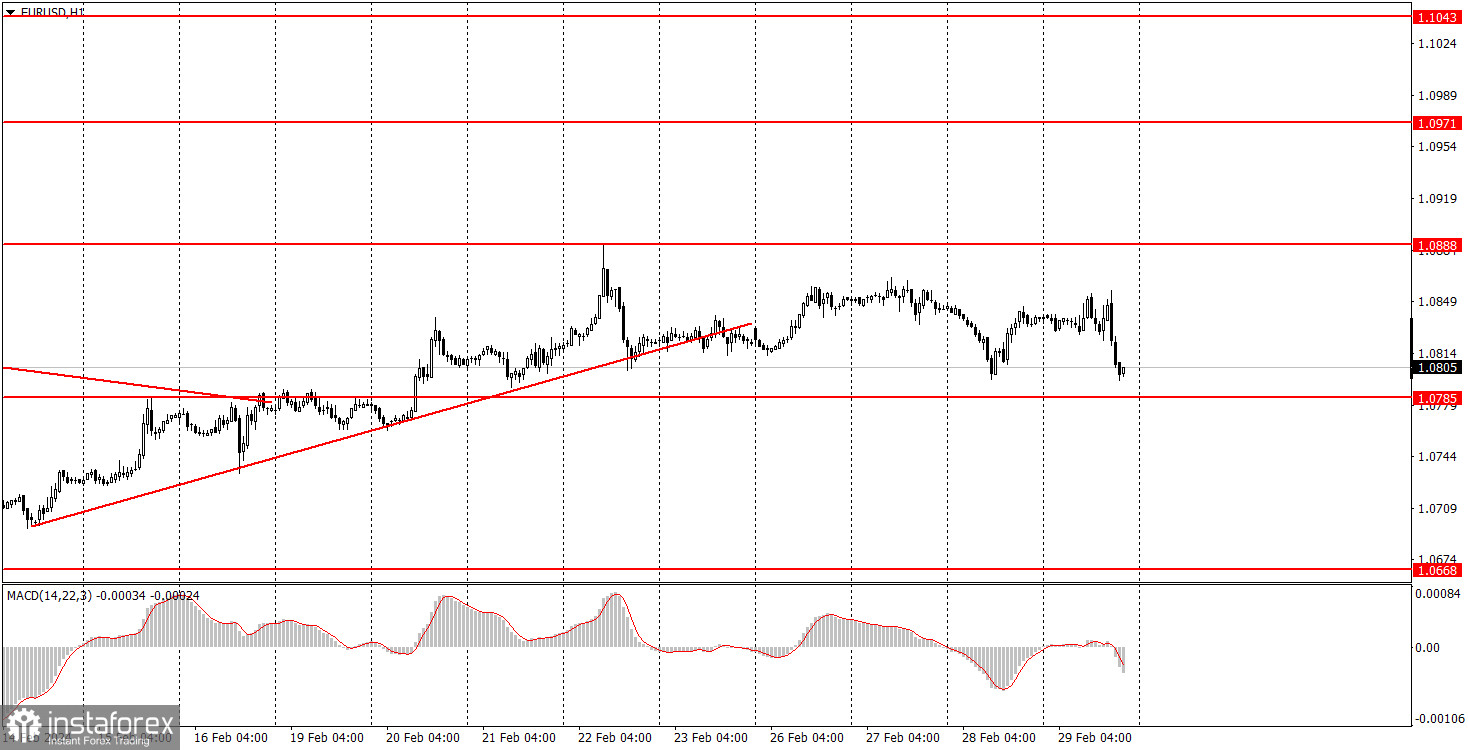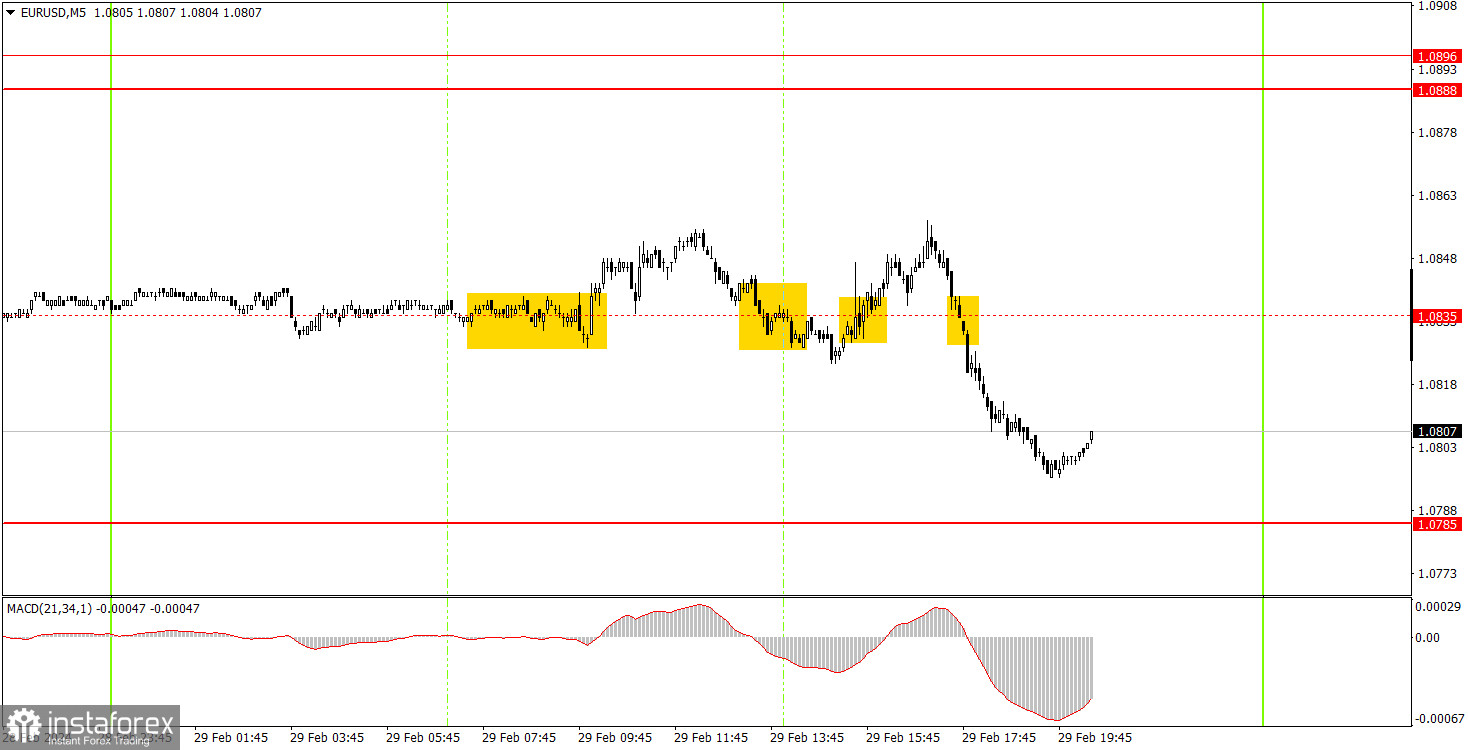Analyzing Thursday's trades:
EUR/USD on 1H chart

EUR/USD showed a decent downward movement on Thursday (although it was not very strong), but it doesn't carry much significance. As clearly seen in the chart above, the pair has been trading within the range of 1.0785 and 1.0888 for the past one and a half weeks. Therefore, even the euro goes through a flat phase. There is no logical explanation behind the pair's decline on Thursday. In the morning, Germany released several reports, which didn't provide support to the euro. One might ask, what's wrong if the euro traded lower? The problem is that the euro started to fall during the US session, indicating that the German data weren't the ones to blame. Even if we assume that Americans started reacting to these reports, why didn't the euro decline right when the trading session opened?
On the contrary, US reports did not support the dollar either. Therefore, it was more logical for the euro to rise in the second half of the day. As we can see, there was no logic behind the pair's movements, and technically, we are facing a flat market.
EUR/USD on 5M chart

Four trading signals were formed around the level of 1.0835 on the 5-minute timeframe. All four were false signals. Novice traders could only make a profit from the last signal, but it should not have been executed since the other three turned out to be false signals. We have repeatedly mentioned that the EUR/USD pair is currently trading in a very sluggish manner. We witnessed a relatively strong movement, but for the most part, the pair still moved predominantly sideways.
Trading tips on Friday:
On the hourly chart, EUR/USD may continue to correct higher for some time, although there are still no macroeconomic and fundamental reasons to support the euro's growth. We still expect a decline from the euro, and in our opinion, it should persist for quite a long time. You may consider short positions once the pair has settled below the level of 1.0785. Until then, a flat market may persist.
The key levels on the 5M chart are 1.0568, 1.0611-1.0618, 1.0668, 1.0725, 1.0767-1.0785, 1.0888-1.0896, 1.0940, 1.0971-1.0981, 1.1011, 1.1043, 1.1091. Friday will bring the pan-European Harmonized Index of Consumer Prices inflation for February, as well as a less significant Manufacturing Purchasing Managers' Index. The US will release a crucial report on February's ISM Manufacturing and a less significant University of Michigan Consumer Sentiment Index. Volatility may be slightly higher than usual.
Basic trading rules:
1) Signal strength is determined by the time taken for its formation (either a bounce or level breach). A shorter formation time indicates a stronger signal.
2) If two or more trades around a certain level are initiated based on false signals, subsequent signals from that level should be disregarded.
3) In a flat market, any currency pair can produce multiple false signals or none at all. In any case, the flat trend is not the best condition for trading.
4) Trading activities are confined between the onset of the European session and mid-way through the U.S. session, after which all open trades should be manually closed.
5) On the 30-minute timeframe, trades based on MACD signals are only advisable amidst substantial volatility and an established trend, confirmed either by a trendline or trend channel.
6) If two levels lie closely together (ranging from 5 to 15 pips apart), they should be considered as a support or resistance zone.
How to read charts:
Support and Resistance price levels can serve as targets when buying or selling. You can place Take Profit levels near them.
Red lines represent channels or trend lines, depicting the current market trend and indicating the preferable trading direction.
The MACD(14,22,3) indicator, encompassing both the histogram and signal line, acts as an auxiliary tool and can also be used as a signal source.
Significant speeches and reports (always noted in the news calendar) can profoundly influence the price dynamics. Hence, trading during their release calls for heightened caution. It may be reasonable to exit the market to prevent abrupt price reversals against the prevailing trend.
Beginning traders should always remember that not every trade will yield profit. Establishing a clear strategy coupled with sound money management is the cornerstone of sustained trading success.





















